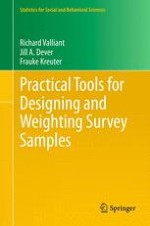2013 | OriginalPaper | Buchkapitel
4. Power Calculations and Sample Size Determination
verfasst von : Richard Valliant, Jill A. Dever, Frauke Kreuter
Erschienen in: Practical Tools for Designing and Weighting Survey Samples
Verlag: Springer New York
Aktivieren Sie unsere intelligente Suche, um passende Fachinhalte oder Patente zu finden.
Wählen Sie Textabschnitte aus um mit Künstlicher Intelligenz passenden Patente zu finden. powered by
Markieren Sie Textabschnitte, um KI-gestützt weitere passende Inhalte zu finden. powered by
